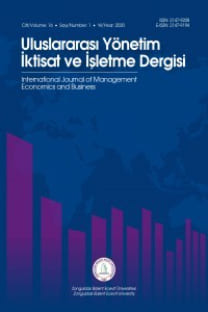THE INVESTIGATION OF RELATIONSHIP BETWEEN CORRUPTION PERCEPTION INDEX AND GDP IN THE CASE OF THE BALKANS
Balkan States Corruption Perception Index, GDP,
___
- Ackerman, S. R. (1999). Corruption and government, causes, consequences, and reform. Cambridge: Cambridge University Press.
- Andving, J., Fjeldstad, O., & Sissener, T. (2000). Research on corruption: a policy oriented survey. Final Repor. December. Oslo: Commissioned by NORAD.
- Gülmez, A. (2015). OECD ülkelerinde ekonomik büyüme ve hava kirliliği ilişkisi: panel veri analizi. Kastamonu Üniversitesi İktisadi ve İdari Bilimler Fakültesi Dergisi, 9(3), ss. 18-30.
- Gillanders, R., & Neselevska, O. (2018). Public sector corruption and trust in the private sector. Journal of International Development(30), ss. 1288-1317.
- Gurgur, T., & Shah, A. (2014). Localization and corruption : panacea or pandora’s box? Annals of economics and finance, Society for AEF, May, 15(1), ss. 109-136.
- Lučić, D., Radišić, M., & Dušan, D. (2016). Causality between corruption and the level of gdp. Economic Research-Ekonomska Istraživanja, 29 (1), ss. 360–379.
- Kao, C., & Chiang, M.H. (1998). On the estimation and Inference of a cointegrated regression in panel data. Working Paper, Center for Policy Research, Syracuse University.
- Koçak, E., & Nisfet, U. (2018). Demokrasi, ekonomik özgürlükler ve ekonomik büyüme: kurumların rolü üzerine bir araştırma. Sosyoekonomi, 26(36), ss. 81-102.
- Kök, R. ve Şimşek, N., (2006). Endüstri-İçi Dış Ticaret, Patentler ve Uluslar Arası Teknolojik Yayılma. UEK TEK Uluslararası Ekonomi Konferansı, Ankara 11-13 Eylül.
- Kök, Recep, M.Serdar İSPİR ve A.Aydır ARI (2010). Zengin Ülkelerden Azgelişmiş Ülkelere Kaynak Aktarma mekanizmasının Gerekliliği ve Evrensel Bölüşüm Parametresi üzerine Bir İnceleme. Uluslararası Ekonomi Konferansı, Türkiye Ekonomi Kurumu, Girne 1-3 Eylül.
- Mani, M., Fredriksson, P., & Richard, D. (2004). The persistence of corruption and regulatory compliance failures: theory and evidence. Public Choice. December121(3-4), 363-390.
- Mark, N.C., & Sul, D (2003). Co integration vector estimation by panel dols and long-run money demand. Oxford Bulletin of Economics and Statistics, 65(5), ss. 655-680.
- Mustapha, N. (2014). The impact of corruption on gdp per capita. Journal Of Eastern European And Central Asian Research, 1(2), ss. 1-5.
- Nazlıoğlu, Ş. (2010). Makro iktisat politikalarının tarım sektörü üzerindeki etkileri: gelişmiş ve gelişmekte olan ülkeler için bir karşılaştırma. Institute of social sciences of Erciyes University , Economy. Unpublished Phd Thesis, Kayseri.
- Paldam, M. (2001). Corruption and religion adding to the economic model. Kyklos International Review For Social Sciences, 54(2/3), ss. 383-414.
- Paldam, M. (2002). The cross-country pattern of corruption: economics, culture and the seesaw dynamics. European Journal of Political Economy, 18(2), ss. 215-240.
- Pedroni, P. (2000). Fully modified ols for heterogeneous cointegrated panels. Advances In Econometrics, (15)ss. 93-130.
- Pedroni, P. (2001). Purchasing power parity tests in cointegrated panels. Review Of Economics and statistics, 83(4), ss. 727-731.
- Rose, R., & Mishler, W. (2010). Experience versus perception of corruption: russia as a test case. Global Crime, 11(2), ss. 145-163.
- Sören, H., & Rothstein, B. (2011). Correlates of corruption. The Quality Of Goverment Institute. Gotenburg: University of Gothenburg.
- Stapenhurst, R. (2000). The media’s role in curbing corruption, Washington, Dc 20433, Usa.: World Bank Institute (Wbi).
- Tanzi, V., & Davoodi, H. (2000). Corruption, growth and public finances. IMF Working Paper, Nowember, IMF.
- Thach, N., Duong, M., & Oanh, T. (2017). Effects of corruption on economic growth - empirical study of asia countries. Imperial Journal Of Interdisciplinary Research (Ijir), 3(7), 791-804.
- Uğur, N., & Dasgupta, M. (2011). Evidence on the economic growth impacts of corruption in lowincome countries and beyond: a systematic review. London: Eppi-Centre. Social Science Research Unit, Institute Of Education, University Of London.
- Ulman, S.R. (2014). Different levels of corruption influence on the main components of the macroeconomic environment. Procedia Economics And Finance(16), 438-447.
- Vasileva, V. (2017). The place of balkan countries in world tourism. International Scientific Refereed Online Journal With Impact Factor , January, (29), 33-43.
- Vito , T. (1998). Corruption around the world: causes, consequences, scope, and cures. www.Transperency .Org./Cpi. Date accessed (01/03/2019)
- ISSN: 2147-9208
- Yayın Aralığı: 4
- Başlangıç: 2005
- Yayıncı: Zonguldak Bülent Ecevit Üniversitesi
TÜRKİYE’DE EV-DIŞI YEMEK YEME ALIŞKANLIĞININ ANALİZİ
Onur DEMİREL, Selim Adem HATIRLI
Mehmet Sedat UĞUR, Murat PÜTÜN
KONJONKTÜR DALGALARININ BELİRLEYİCİLERİ: G7 VE E7 ÜLKELERİ ÜZERİNE KARŞILAŞTIRMALI BİR ANALİZ
MARKA ADININ TÜKETİCİLERİN MARKA TERCİHİNE ETKİSİ: TÜRKÇE VE İNGİLİZCE ADLARIN KARŞILAŞTIRILMASI
BELEDİYELERDE ULAŞIM GÜZERGÂHLARININ DNA HESAPLAMA YÖNTEMİYLE İYİLEŞTİRİLMESİ
Salih Serkan KALELİ, Mehmet BAYĞIN, Abdullah NARALAN
İbrahim Emre GÖKTÜRK, Hüseyin Serdar YALÇINKAYA
KARBON FİYATLARININ SİMETRİK VE ASİMETRİK NEDENSELLİK TESTİ İLE ANALİZİ
Mehmet Fatih BAYRAMOĞLU, Tezcan ABASIZ, Mehmet ERGÜN
GEÇİŞ EKONOMİLERİNDE DIŞ BORÇLANMAYI ETKİLEYEN FAKTÖRLER: ORTA ASYA VE KAFKAS ÜLKELERİ ÖRNEĞİ
